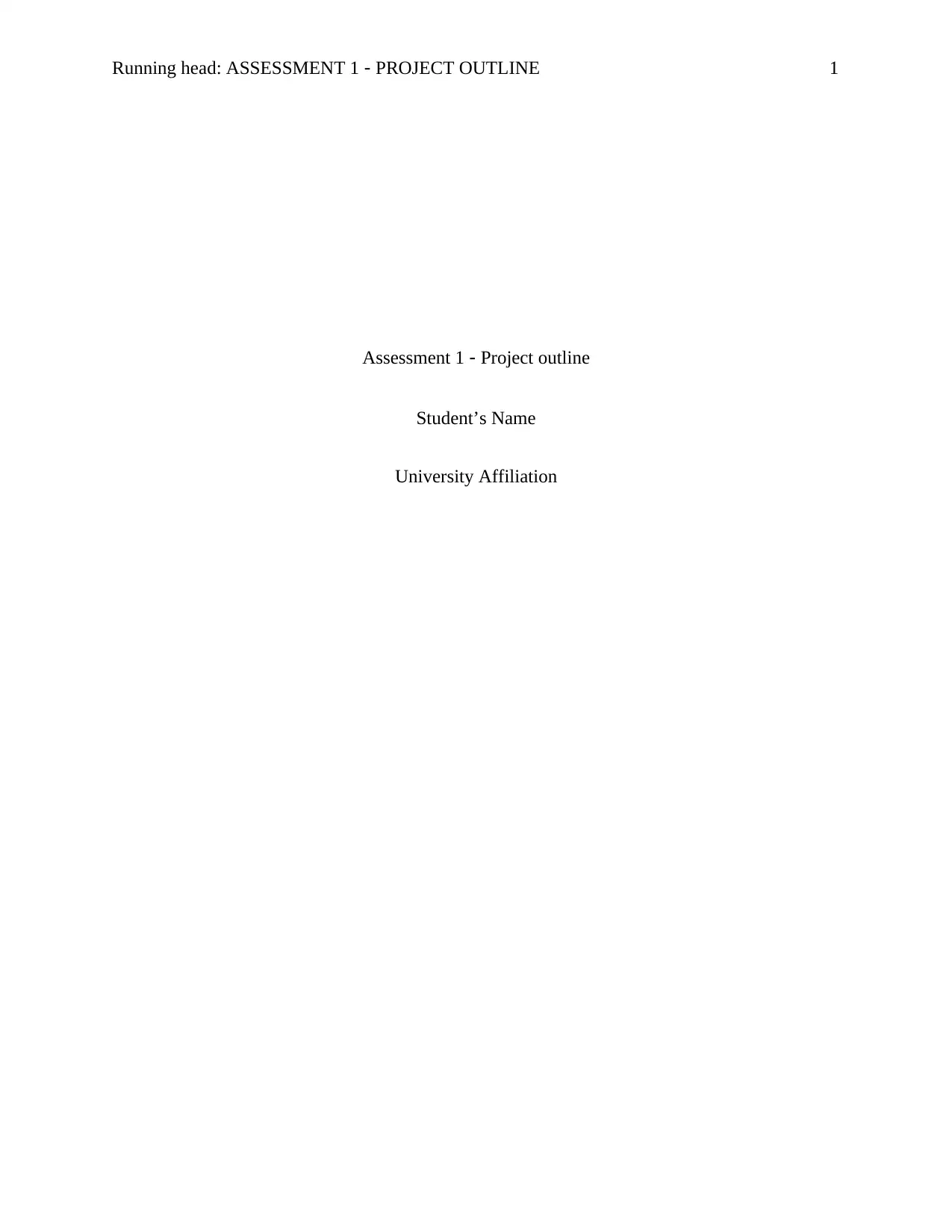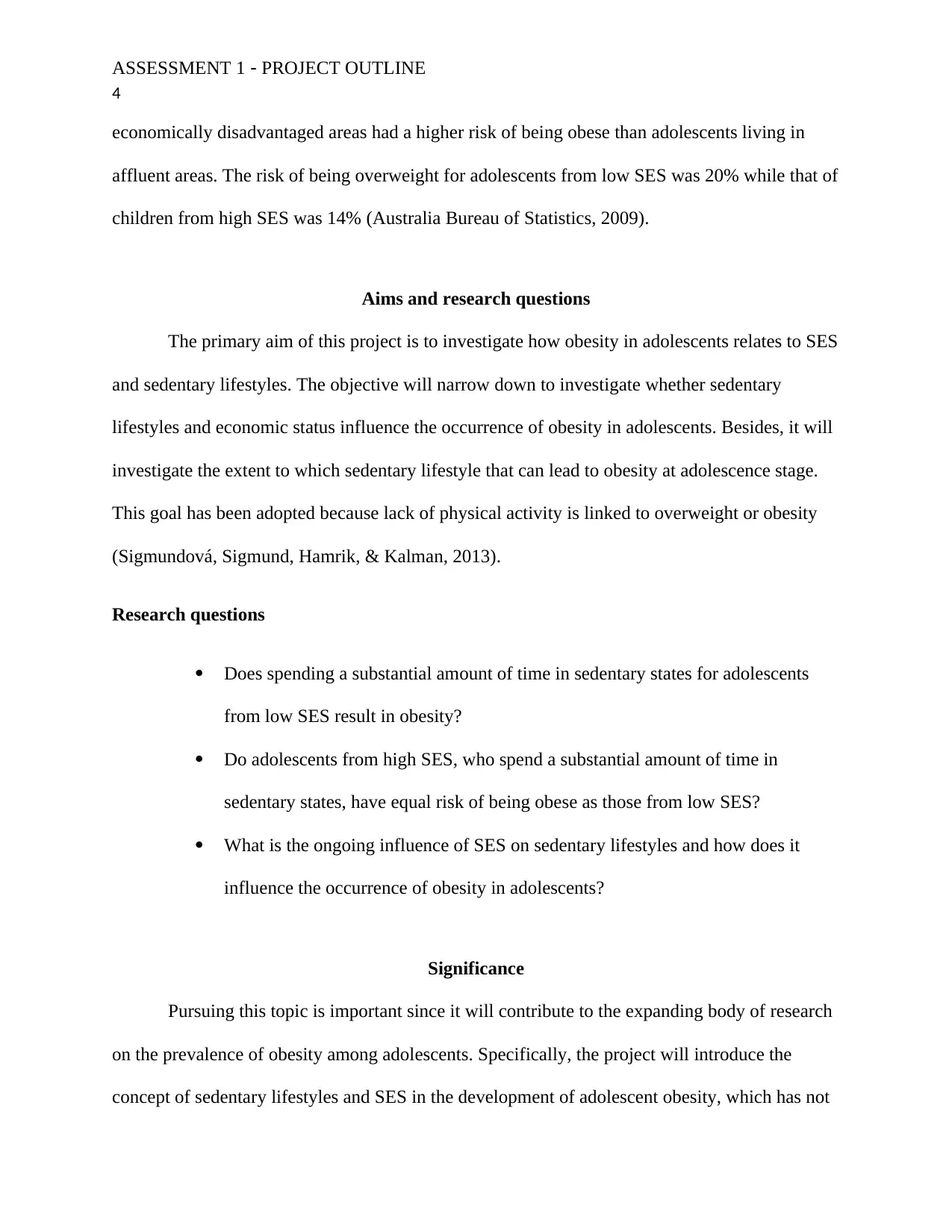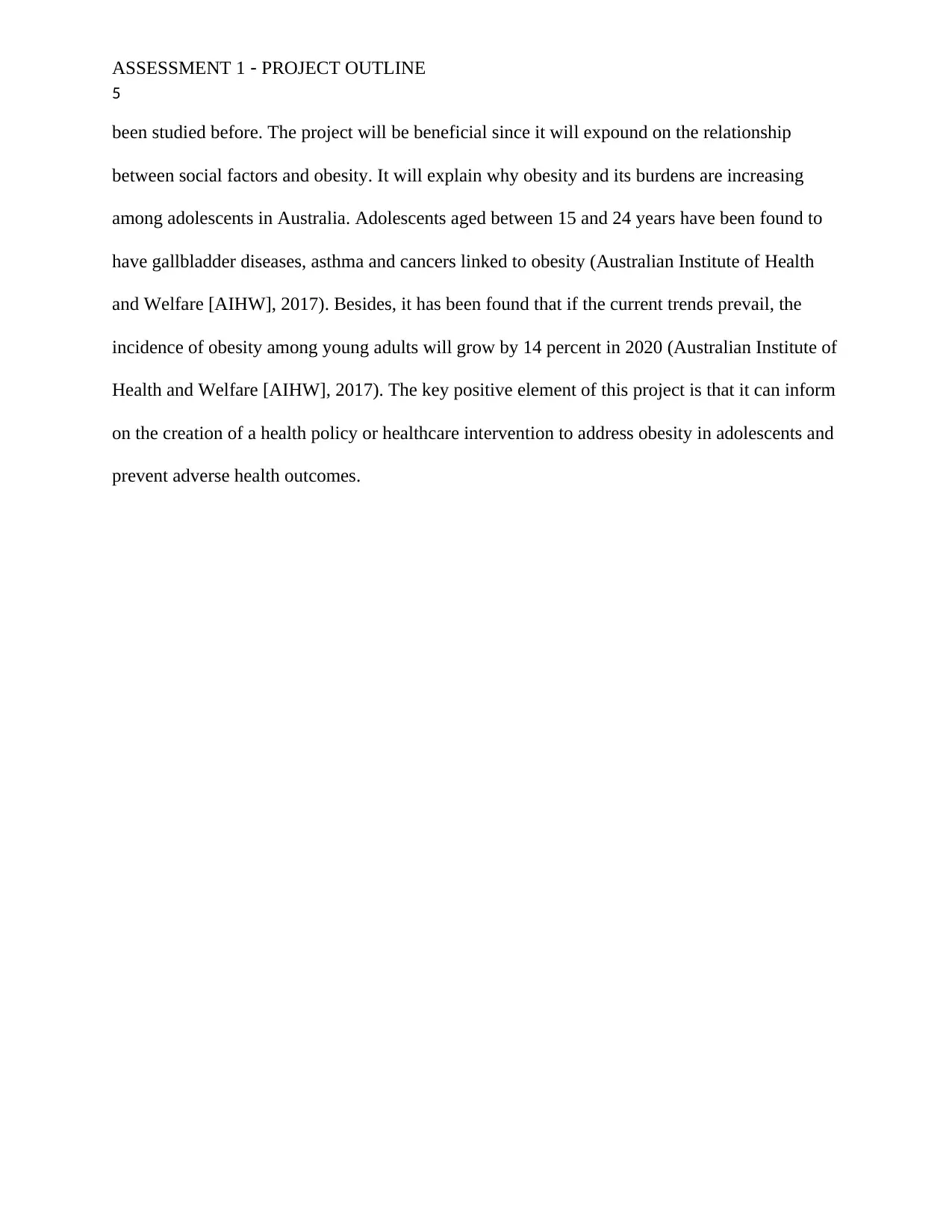Assessment 1: Project Outline on Adolescent Obesity
VerifiedAdded on 2020/03/28
|6
|940
|100
Report
AI Summary
This project outline explores the relationship between socioeconomic status (SES), sedentary lifestyles, and obesity among Australian adolescents. The research aims to investigate how obesity in adolescents relates to SES and sedentary behaviors like TV viewing and computer use. It poses research questions about the impact of sedentary time and SES on obesity risk. The project's significance lies in contributing to research on adolescent obesity, examining the influence of social factors, and informing health policy interventions. The outline includes a literature review, background information on the prevalence of obesity in Australia, and a discussion of the project's aims, research questions, and significance. The project highlights the increasing prevalence of obesity and its link to health issues, emphasizing the need for further investigation into the factors influencing adolescent obesity.

Running head: ASSESSMENT 1 ‐ PROJECT OUTLINE 1
Assessment 1 ‐ Project outline
Student’s Name
University Affiliation
Assessment 1 ‐ Project outline
Student’s Name
University Affiliation
Paraphrase This Document
Need a fresh take? Get an instant paraphrase of this document with our AI Paraphraser

ASSESSMENT 1 ‐ PROJECT OUTLINE
2
Contents
Research topic..................................................................................................................................2
Background......................................................................................................................................2
Aims and research questions...........................................................................................................3
Significance.....................................................................................................................................3
References........................................................................................................................................5
2
Contents
Research topic..................................................................................................................................2
Background......................................................................................................................................2
Aims and research questions...........................................................................................................3
Significance.....................................................................................................................................3
References........................................................................................................................................5

ASSESSMENT 1 ‐ PROJECT OUTLINE
3
Assessment 1 ‐ Project outline
Research topic
Topic: Relationship between socioeconomic status (SES), sedentary lifestyles and obesity
among Australian adolescents. Sedentary lifestyle is too much sitting and failure to undertake
any physical activities. The most common types of sedentary lifestyles in adolescents are TV
viewing, game-console use, and computer use (Owen, Healy, GN, Matthews, & Dunstan, 2010).
Adolescents from high SES have high chances of embracing sedentary lifestyle; however, they
have access to good diet and health education, which might reduce the incidence of obesity.
Contrarily, adolescents from low SES have low chances living sedentary lifestyles; however,
they lack access to good nutrition and health education, which might increase the occurrence of
obesity.
Background
The prevalence of obesity and association with SES is already characterised. Thus, the
research seeks to identify the relationship between SES and obesity and sedentary lifestyles such
as sleeping, computer use and TV viewing (Konevic, Martinovic, & Djonovic, 2015). Obesity is
significant burden in Australian health care system and one of the NHPAs (Australian Institute of
Health and Welfare [AIHW], 2016). Approximately 20 to 25 percent of adolescents in Australia
are obese or overweight. In 2007-2008, about one-quarter of adolescents aged 5 to 17 years were
overweight or obese. This finding indicates that there was a 4% increase in the number of obese
adolescents from 1995 (Australia Bureau of Statistics, 2009). Based on this finding, the
prevalence of obesity is increasing significantly. A recent study found that adolescents living in
3
Assessment 1 ‐ Project outline
Research topic
Topic: Relationship between socioeconomic status (SES), sedentary lifestyles and obesity
among Australian adolescents. Sedentary lifestyle is too much sitting and failure to undertake
any physical activities. The most common types of sedentary lifestyles in adolescents are TV
viewing, game-console use, and computer use (Owen, Healy, GN, Matthews, & Dunstan, 2010).
Adolescents from high SES have high chances of embracing sedentary lifestyle; however, they
have access to good diet and health education, which might reduce the incidence of obesity.
Contrarily, adolescents from low SES have low chances living sedentary lifestyles; however,
they lack access to good nutrition and health education, which might increase the occurrence of
obesity.
Background
The prevalence of obesity and association with SES is already characterised. Thus, the
research seeks to identify the relationship between SES and obesity and sedentary lifestyles such
as sleeping, computer use and TV viewing (Konevic, Martinovic, & Djonovic, 2015). Obesity is
significant burden in Australian health care system and one of the NHPAs (Australian Institute of
Health and Welfare [AIHW], 2016). Approximately 20 to 25 percent of adolescents in Australia
are obese or overweight. In 2007-2008, about one-quarter of adolescents aged 5 to 17 years were
overweight or obese. This finding indicates that there was a 4% increase in the number of obese
adolescents from 1995 (Australia Bureau of Statistics, 2009). Based on this finding, the
prevalence of obesity is increasing significantly. A recent study found that adolescents living in
⊘ This is a preview!⊘
Do you want full access?
Subscribe today to unlock all pages.

Trusted by 1+ million students worldwide

ASSESSMENT 1 ‐ PROJECT OUTLINE
4
economically disadvantaged areas had a higher risk of being obese than adolescents living in
affluent areas. The risk of being overweight for adolescents from low SES was 20% while that of
children from high SES was 14% (Australia Bureau of Statistics, 2009).
Aims and research questions
The primary aim of this project is to investigate how obesity in adolescents relates to SES
and sedentary lifestyles. The objective will narrow down to investigate whether sedentary
lifestyles and economic status influence the occurrence of obesity in adolescents. Besides, it will
investigate the extent to which sedentary lifestyle that can lead to obesity at adolescence stage.
This goal has been adopted because lack of physical activity is linked to overweight or obesity
(Sigmundová, Sigmund, Hamrik, & Kalman, 2013).
Research questions
Does spending a substantial amount of time in sedentary states for adolescents
from low SES result in obesity?
Do adolescents from high SES, who spend a substantial amount of time in
sedentary states, have equal risk of being obese as those from low SES?
What is the ongoing influence of SES on sedentary lifestyles and how does it
influence the occurrence of obesity in adolescents?
Significance
Pursuing this topic is important since it will contribute to the expanding body of research
on the prevalence of obesity among adolescents. Specifically, the project will introduce the
concept of sedentary lifestyles and SES in the development of adolescent obesity, which has not
4
economically disadvantaged areas had a higher risk of being obese than adolescents living in
affluent areas. The risk of being overweight for adolescents from low SES was 20% while that of
children from high SES was 14% (Australia Bureau of Statistics, 2009).
Aims and research questions
The primary aim of this project is to investigate how obesity in adolescents relates to SES
and sedentary lifestyles. The objective will narrow down to investigate whether sedentary
lifestyles and economic status influence the occurrence of obesity in adolescents. Besides, it will
investigate the extent to which sedentary lifestyle that can lead to obesity at adolescence stage.
This goal has been adopted because lack of physical activity is linked to overweight or obesity
(Sigmundová, Sigmund, Hamrik, & Kalman, 2013).
Research questions
Does spending a substantial amount of time in sedentary states for adolescents
from low SES result in obesity?
Do adolescents from high SES, who spend a substantial amount of time in
sedentary states, have equal risk of being obese as those from low SES?
What is the ongoing influence of SES on sedentary lifestyles and how does it
influence the occurrence of obesity in adolescents?
Significance
Pursuing this topic is important since it will contribute to the expanding body of research
on the prevalence of obesity among adolescents. Specifically, the project will introduce the
concept of sedentary lifestyles and SES in the development of adolescent obesity, which has not
Paraphrase This Document
Need a fresh take? Get an instant paraphrase of this document with our AI Paraphraser

ASSESSMENT 1 ‐ PROJECT OUTLINE
5
been studied before. The project will be beneficial since it will expound on the relationship
between social factors and obesity. It will explain why obesity and its burdens are increasing
among adolescents in Australia. Adolescents aged between 15 and 24 years have been found to
have gallbladder diseases, asthma and cancers linked to obesity (Australian Institute of Health
and Welfare [AIHW], 2017). Besides, it has been found that if the current trends prevail, the
incidence of obesity among young adults will grow by 14 percent in 2020 (Australian Institute of
Health and Welfare [AIHW], 2017). The key positive element of this project is that it can inform
on the creation of a health policy or healthcare intervention to address obesity in adolescents and
prevent adverse health outcomes.
5
been studied before. The project will be beneficial since it will expound on the relationship
between social factors and obesity. It will explain why obesity and its burdens are increasing
among adolescents in Australia. Adolescents aged between 15 and 24 years have been found to
have gallbladder diseases, asthma and cancers linked to obesity (Australian Institute of Health
and Welfare [AIHW], 2017). Besides, it has been found that if the current trends prevail, the
incidence of obesity among young adults will grow by 14 percent in 2020 (Australian Institute of
Health and Welfare [AIHW], 2017). The key positive element of this project is that it can inform
on the creation of a health policy or healthcare intervention to address obesity in adolescents and
prevent adverse health outcomes.

ASSESSMENT 1 ‐ PROJECT OUTLINE
6
References
Australia Bureau of Statistics. (2009). Children who are overweight or obese. Retrieved 9 30,
2017, from
http://www.ausstats.abs.gov.au/ausstats/subscriber.nsf/0/C3ADD4130334512BCA25763
A0018BE55/$File/41020_childhoodobesity.pdf
Australian Institute of Health and Welfare [AIHW]. (2017). Impact of overweight and obesity as
a risk factor for chronic conditions: Australian Burden of Disease Study. Canberra:
AIHW.
Australian Institute of Health and Welfare [AIHW]. (2016). National Health Priority Areas.
Retrieved 9 30, 2017, from Canberra: AIHW: http://www.aihw.gov.au/national-health-
priority-areas/
Konevic, S., Martinovic, J., & Djonovic, N. (2015). Association of Socioeconomic Factors and
Sedentary Lifestyle in Belgrade’s Suburb, Working Class Community. Iranian journal of
public health , 44 (8), 1053-1060.
Sigmundová, D., Sigmund, E., Hamrik, Z., & Kalman, M. (2013). Trends of overweight and
obesity, physical activity and sedentary behaviour in Czech schoolchildren: HBSC study.
The European Journal of Public Health , 24 (2), 210-215.
6
References
Australia Bureau of Statistics. (2009). Children who are overweight or obese. Retrieved 9 30,
2017, from
http://www.ausstats.abs.gov.au/ausstats/subscriber.nsf/0/C3ADD4130334512BCA25763
A0018BE55/$File/41020_childhoodobesity.pdf
Australian Institute of Health and Welfare [AIHW]. (2017). Impact of overweight and obesity as
a risk factor for chronic conditions: Australian Burden of Disease Study. Canberra:
AIHW.
Australian Institute of Health and Welfare [AIHW]. (2016). National Health Priority Areas.
Retrieved 9 30, 2017, from Canberra: AIHW: http://www.aihw.gov.au/national-health-
priority-areas/
Konevic, S., Martinovic, J., & Djonovic, N. (2015). Association of Socioeconomic Factors and
Sedentary Lifestyle in Belgrade’s Suburb, Working Class Community. Iranian journal of
public health , 44 (8), 1053-1060.
Sigmundová, D., Sigmund, E., Hamrik, Z., & Kalman, M. (2013). Trends of overweight and
obesity, physical activity and sedentary behaviour in Czech schoolchildren: HBSC study.
The European Journal of Public Health , 24 (2), 210-215.
⊘ This is a preview!⊘
Do you want full access?
Subscribe today to unlock all pages.

Trusted by 1+ million students worldwide
1 out of 6
Related Documents
Your All-in-One AI-Powered Toolkit for Academic Success.
+13062052269
info@desklib.com
Available 24*7 on WhatsApp / Email
![[object Object]](/_next/static/media/star-bottom.7253800d.svg)
Unlock your academic potential
Copyright © 2020–2025 A2Z Services. All Rights Reserved. Developed and managed by ZUCOL.





